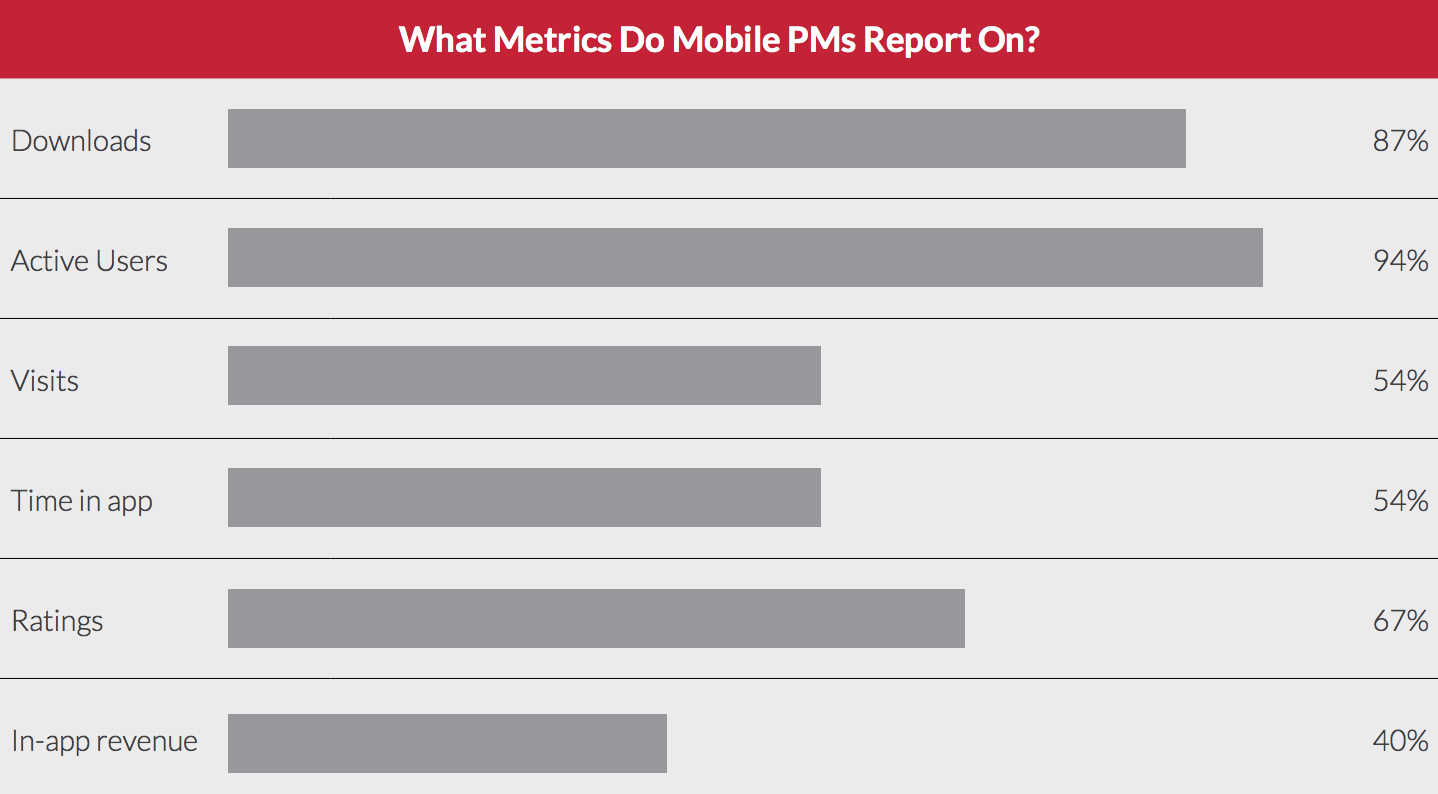Mobile product managers have a plethora of metrics to choose from when it comes to determining the success of their products, and it can be difficult to understand which metrics are the most meaningful.
To get a sense of what metrics matter most, we asked 100 mobile product managers who work on iOS devices (63%) and Android devices (37%) in order to learn as much as we could about the metrics they report on that they consider to be the most vital.
Here’s what we learned:
Downloads, active users, visits, time spent in-app, ratings, and in-app revenue are definitely all-important metrics to help determine whether or not your app has been successful. But there’s plenty more to consider when you’re gauging the true health of your mobile product.
In order to get more budget for your projects and to better communicate across teams, it’s important to look at your metrics in a meaningful, actionable way. For best results, we recommend dividing your success metrics in four main categories to help you see the forest for the trees.
Here are 16 metrics that matter most for mobile product managers (along with some cute kittens, because don’t they always make data processing better?), broken down by category:
1. Customer Activity Metrics
Customer activity metrics are any daily/weekly/monthly activities you track about the actions your customers are taking. Mobile product managers will likely be the most familiar with this section as customer activity is generally tracked by Product and Customer Success teams.
Track the following mobile app metrics to gauge customer activity health:
Downloads
Downloads are the number of people who have downloaded and installed your app on their device.The most accurate way to track downloads is directly from the app stores. While downloads alone don’t paint the whole picture of success, they sure do help. Measure this metric directly from the app stores. Third-party tools like AppAnnie and AppFigures can help you crawl the app stores to get the most accurate download data.
Monthly Active Users (MAU)
Monthly active users (MAU) counts the number of unique users over the course of a month.
To calculate, count the number of unique users during the previous 30 days to understand
how many users have been active in your product.
Daily Active Users (DAU)
Daily active users (DAU) counts the number of unique users in a one day. To calculate, count
the number of unique users during the previous 24 hours to understand how many users
have been active in your product.
Session Length
Session length is the period of time between app open and app close, or app time out. It
indicates how much time your users are spending in your app per individual session. To
find this metric, calculate how long a user is in your app from the time they open the app
to the time they close it. Once you have individual data, segment your users to see which
groups spend more time in your app and why. Tracking the length of sessions is particularly
important for unlocking revenue potential in your app flows.
Session Interval
Session interval is the time between the user’s first session and their next session. This
metric shows the frequency in which users open the app and how sticky your app is. To
calculate, pull the time a user has spent from when they last close your app to the next time
they open it. When you know the typical time lapse between sessions per audience segment,
you can use that information to optimize the customer experience to encourage more
frequent app usage. Consider using in-app messaging to create a more immersive experience
for your customers.
Time In-App
Time in-app tracks how long a person was in your app over a period of time. It identifies how often your app is being used and is an indicator of how valuable your app is. To calculate, select a certain time period and add all of the session lengths for an individual user during that time period. By identifying how often users engage with your app, you can identify behavior and patterns over time. If a certain segment of customers consistently opens your app for a long periods of time, dig into why.
2. Conversion and Retention Metrics
All data that focus on conversion and retention should be placed in this category. Marketing teams are typically responsible for these calculations, so sync with your Marketing department for tips on pulling data before diving in.
Track the following metrics to gauge conversion and retention health:
Conversion Rate
The number of potential customers who started a trial and end up converting to paid customers in a set period of time. Conversion is most commonly measured by taking the number of leads or trials in a period of time (weekly, monthly, quarterly, etc.) and dividing by the total number of new customers added during that same period of time. By increasing your conversion rate to customer even a small amount, you can quickly increase your customers, MAU, and revenue.
Churn
A measure of what was lost during a given period of time. Churn can be in dollars, customers, unsubscribes, etc. To calculate, divide the number of customers lost in a month by the prior month total. Once you’ve assessed your customer churn, map out how much revenue was lost (as some customers will be on different payment plans than others). Some amount of churn each month is normal as it’s inevitable that a few customers will cancel, and looking back on historical data will help you better understand how much churn is “healthy” for your team.
Retention
Retention is a measurement of customer churn that tells you how many customers continue to actively use your app in a certain period of time. Aggregate retention is best calculated monthly. To calculate, divide your MAU by the number of installs you get in a given month. To calculate retention for a specific period of time, divide the number of users retained at the end of the time period by the number of installs at the start of the time period.
Love Score
The Love Score is a comprehensive metric based on your app’s popularity, ratings and reviews, customer sentiment, reviewer quality, and Alchemer Mobile (formerly Apptentive)’s internal database with over 50 million mobile customers to compare. To find this metric, plug your metrics into this quick calculator.
3. Revenue Metrics
Revenue goals come from the top-down, and it’s not enough to simply know how much money your mobile product is bringing in. Your CEO and Leadership team is constantly iterating on the company’s revenue goals, so understanding how your mobile product fits into the grand scheme of things is imperative to learn before gauging success.
Track the following metrics to understand how your mobile product affects revenue:
Download Revenue (for Paid Apps)
The percentage of your total company revenue that comes from people downloading your app from the app stores. If your app is free to download, you can skip this metric. Find the percentage of your total revenue driven by your app downloads by dividing your app’s monthly download revenue by your MRR (monthly recurring revenue).
In-App Revenue
In-app revenue is revenue collected from customers as they use the app from purchases, ads, unlocking levels, purchasing points, etc. This metric does not include download revenue. Find the percentage of your total revenue driven by in-app purchases by dividing your app’s monthly in-app revenue by your MRR (monthly recurring revenue).
Lifetime Value
Lifetime value, or LTV, is the estimated total revenue from the customer over the life of the relationship. Determine customer LTV by taking the average revenue per month and multiplying it by the average lifetime of a customer in months. LTV is great at showing growth over time for different segments of your audience (by acquisition channel or by monthly cohorts, for example). This can tell you which customer segment is the most loyal, are the biggest evangelists, and spend the most money.
4. Team Metrics
It’s easy to only look at numbers when calculating success, but don’t forget to look at your team’s health to understand how your mobile product is performing. Whether one or five internal teams have touched a product, it’s important to gather data on everyone involved to understand how the internal machine is movin’ and groovin’.
Calculate the following metrics to understand how well your mobile product team is doing:
Quality of Features Released
This metric helps you understand how the quality of your recently launched product and/ or feature compares to the quality of previously launched products and/or features. Gauging quality isn’t a perfect science, but you know the standards set by your team better than anyone. Dig deep into how you’ve rated features and products in the past, and compare those scores with your most recent release. How does it stack up? This metric is meant to help you understand what you can improve for next time.
Timing of Features Released
This metric helps gauge release timing. It also helps you understand how “feature creep” affected your release so you can better assess what to change for next time. Look at the deadlines and release dates you gave yourself for a feature update/product release/etc. How many deadlines were hit? For the deadlines that weren’t hit, how delayed were they? Take the number of deadlines hit on time and divide them by the total number of deadlines set for the project to give yourself a percentage score. Example: If three out of my five deadlines were hit on time, my team gets a 60% feature release score out of a possible 100%.
Team Sentiment (i.e. “Team Love Score”)
Similar to the Love Score we covered above, this metric takes many different components (including individual happiness, team progress, communication, individual involvement, etc.) into consideration. It’s the least scientific metric metric you can gauge your team’s success on as “sentiment” is quite interpreted; teams (and even individuals) define happiness in different ways, and what works for you may not always work for the next group.
To calculate, think about the “happiness” metrics that matter most to members of your team. Spend time with each team member and allow them to score themselves and the overall team on each metric, whether through survey, email, or in person. Once everyone weighs in, average the score for each category, then average your averages to come up with a final score.
Wrapping It Up
There are many metrics that matter when it comes to successful mobile product management. I hope the tips above give you a place to start or get you thinking about how you’re currently measuring success in a new way.
For additional tips to help drive your customer activity, conversion, retention, revenue, and team
metrics up and to the right, I recommend reading the following:
- The Advanced Guide to Mobile Product Management
- The Math of the App Business
- 15 Metrics Every Software Product Manager Should Know
- 6 Mobile Marketing Metrics That Matter Most
- Focus on the Metrics that Matter
Happy metric measurement!










